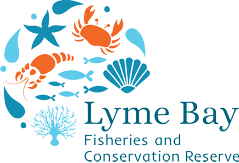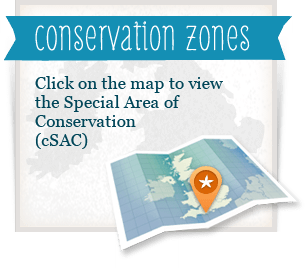Reef Species
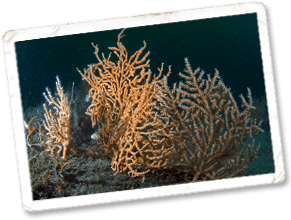
Pink Sea Fans
‘Eunicella verrucosa’ may look like a plant but is actually a coral so is made up of lots of tiny anemone-like polyps that filter nutrients out from the water. Pink sea fans are gorgonions, also known as horny corals due to the horn-like composition of their skeleton. Dogfish also attach their eggs to pink sea-fans, wrapping the long tendrils of the egg case around the sea-fan’s branches. These corals grow very slowly and this makes them very vulnerable to damage.
‘Eunicella verrucosa’ may look like a plant but is actually a coral so is made up of lots of tiny anemone-like polyps that filter nutrients out from the water. Pink sea fans are gorgonions, also known as horny corals due to the horn-like composition of their skeleton. Dogfish also attach their eggs to pink sea-fans, wrapping the long tendrils of the egg case around the sea-fan’s branches. These corals grow very slowly and this makes them very vulnerable to damage.
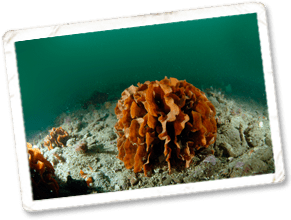
Ross Coral
‘Pentapora foliacea’ are also known as ‘Potato Crisp Bryozoan’ due to their structure of lots of interconnected flat plates. While alive these corals are a beautiful deep orange colour but they fade to white after the coral dies. These corals are especially vulnerable to damage from fishing equipment such as trawls and dredges.
‘Pentapora foliacea’ are also known as ‘Potato Crisp Bryozoan’ due to their structure of lots of interconnected flat plates. While alive these corals are a beautiful deep orange colour but they fade to white after the coral dies. These corals are especially vulnerable to damage from fishing equipment such as trawls and dredges.
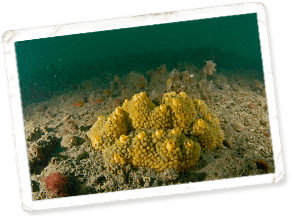
Boring Sponge
‘Cliona celata’ are not called boring sponges because they’re dull but because they bore holes into the calcium carbonate shells and skeletons of animals like scallops, oysters and corals. Using a combination of chemical and mechanical erosion, they dissolve and slowly chip away at dead, diseased, and occasionally healthy organisms. This helps to recycle and refurbish the calcium carbonate and create new space for settlement.
‘Cliona celata’ are not called boring sponges because they’re dull but because they bore holes into the calcium carbonate shells and skeletons of animals like scallops, oysters and corals. Using a combination of chemical and mechanical erosion, they dissolve and slowly chip away at dead, diseased, and occasionally healthy organisms. This helps to recycle and refurbish the calcium carbonate and create new space for settlement.
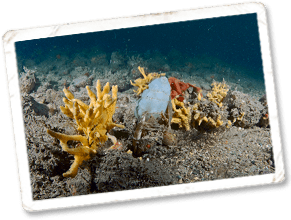
Limestone Boulder
A sediment covered limestone boulder reef in Lyme Bay, Southwest England. The bright yellow tassled sponge can be seen in the foreground and a large white sea squirt in the centre. Both are characteristic species of Lyme Bay reefs. Dogfish egg cases can be seen wrapped around the sea squirt.
A sediment covered limestone boulder reef in Lyme Bay, Southwest England. The bright yellow tassled sponge can be seen in the foreground and a large white sea squirt in the centre. Both are characteristic species of Lyme Bay reefs. Dogfish egg cases can be seen wrapped around the sea squirt.
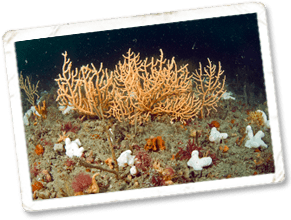
Rich Turf Forms
This picture shows rich turf forms on the edge of a rocky reef in Saw-tooth ledges Reef in Lyme bay. The Saw-tooth ledges make up a very distinctive reef area in Lyme Bay. It is a series of limestone steps where some are only a few centimetres high, but some are several metres high (hence the name 'saw-tooth'). Close to the edges of the reef, where tides are strongest, rich assemblages of filter-feeding species form.
This picture shows rich turf forms on the edge of a rocky reef in Saw-tooth ledges Reef in Lyme bay. The Saw-tooth ledges make up a very distinctive reef area in Lyme Bay. It is a series of limestone steps where some are only a few centimetres high, but some are several metres high (hence the name 'saw-tooth'). Close to the edges of the reef, where tides are strongest, rich assemblages of filter-feeding species form.
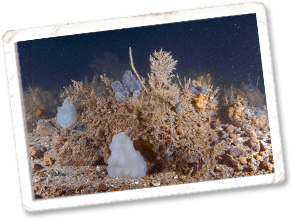
Sediment Covered Limestone Boulder
A sediment covered limestone boulder reef in Lyme Bay creates a unique are that allows for sediment tolerant species to grow on the reefs. The rock reefs of Lyme bay are mostly low lying and frequently covered with a thin layer of fine sand. This creates a particular habitat which is very favourable for sea squirts.
A sediment covered limestone boulder reef in Lyme Bay creates a unique are that allows for sediment tolerant species to grow on the reefs. The rock reefs of Lyme bay are mostly low lying and frequently covered with a thin layer of fine sand. This creates a particular habitat which is very favourable for sea squirts.

